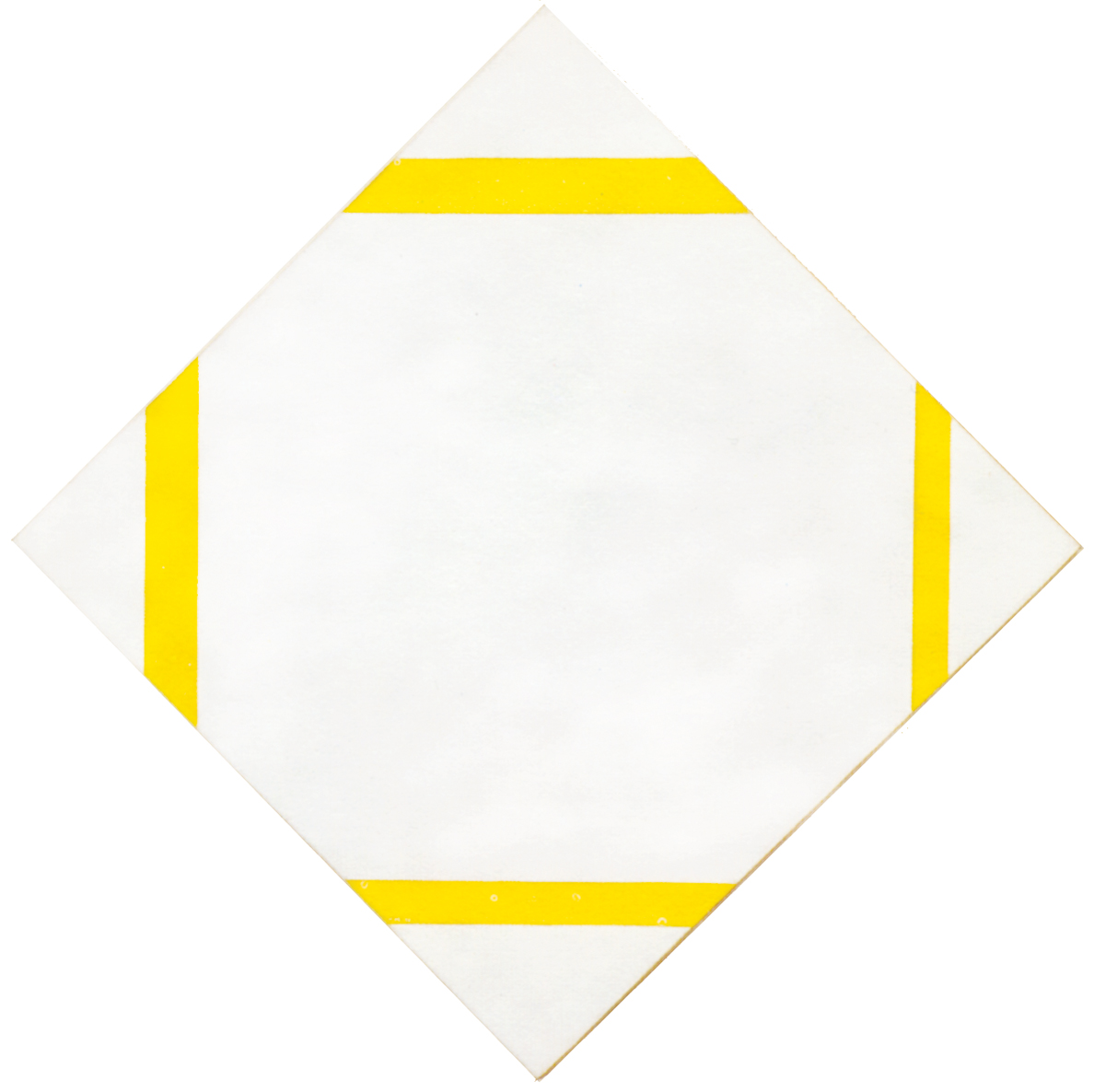Please note: If on devices you click on links to images and/or text that do not open if they should, just slightly scroll the screen to re-enable the function. Strange behavior of WordPress.
In addition to still lifes, single flowers, landscapes, dunes, buildings, and trees, between 1901 and 1911 Piet Mondrian produced a series of works that are usually described as symbolist. I refer to his female figures in attitudes of contemplation or devotion with one or two flowers as symbols of purity and equilibrium. The flowers are thus supposed to symbolize a process of inner purification:
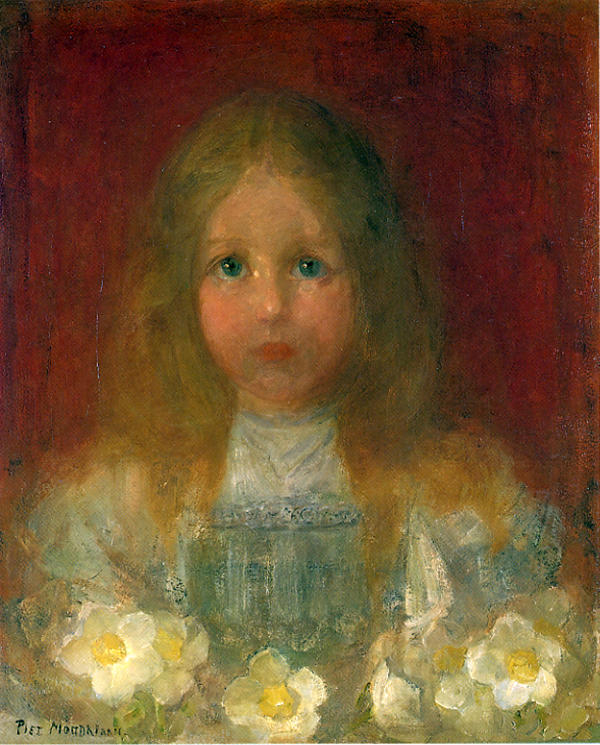
Oil on Canvas, cm. 44 x 53
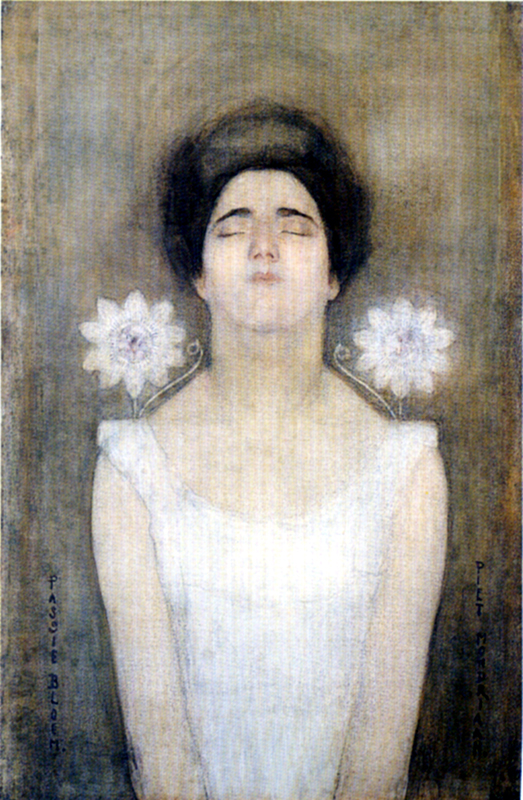
Watercolor on Paper, cm. 47,5 x 72,5
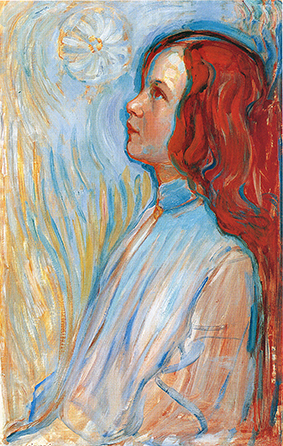
Oil on Canvas, cm. 61 x 94
Theosophy
I believe that it is perhaps exaggerated to speak of symbolism here. These are works that show Mondrian’s sensitivity toward themes of a more universal nature and constitute a prelude to his later interest in the theosophical doctrine.
However, these paintings constituted no more than a phase of transition toward the development of a wholly visual language. As Michele Seuphor says, “The development of Mondrian’s religious thought can therefore be summarized as follows: Calvinism is superseded by theosophy, which is itself absorbed (after 1916) by Neoplasticism called upon to express everything wordlessly.“
Mondrian often had conversations with his friend Albert van den Briel on themes of a spiritual character in this period. He read Edouard Schurè‘s book on “The Great Initiates”, one of the few he was to keep with him all through his life, it being his habit to give books away after reading them so as to increase the circulation of good ideas. Schurè’s initiates were those capable of perceiving the universal truths concealed behind the changing appearances of everyday life.
“Mondrian, as we know, always gave a clear preference to the new. Because the new is on the move and is synonymous with life. His key word was evolution. I don’t think he ever read Creative Evolution, but in the little book of Krishnamurti I mentioned earlier, which he kept until his death, I find this reflection of Bergson‘s thought, a little more religiously dressed: “A man’s religion, the race to which he belongs, are unimportant things; what really matters is the knowledge of God’s plan for men. For God has a plan, and that plan is evolution.
As soon as man has understood this plan and really knows it, he can only collaborate in its realization and identify himself with it. This is its glory and its beauty. Thus, because he has knowledge he is on God’s side, firmly devoted to good and resisting evil, working for evolution and not for his own interest.” And that call again, which could very well serve as an epigraph to Mondrian’s entire life: “Be an evolution-oriented force!”
Michel Seuphor, Piet Mondrian, Sa Vie, son Oeuvre, 1956
I shall discuss the one I regard as most representative of the so called symbolistic phase of Mondrian, namely Evolution:
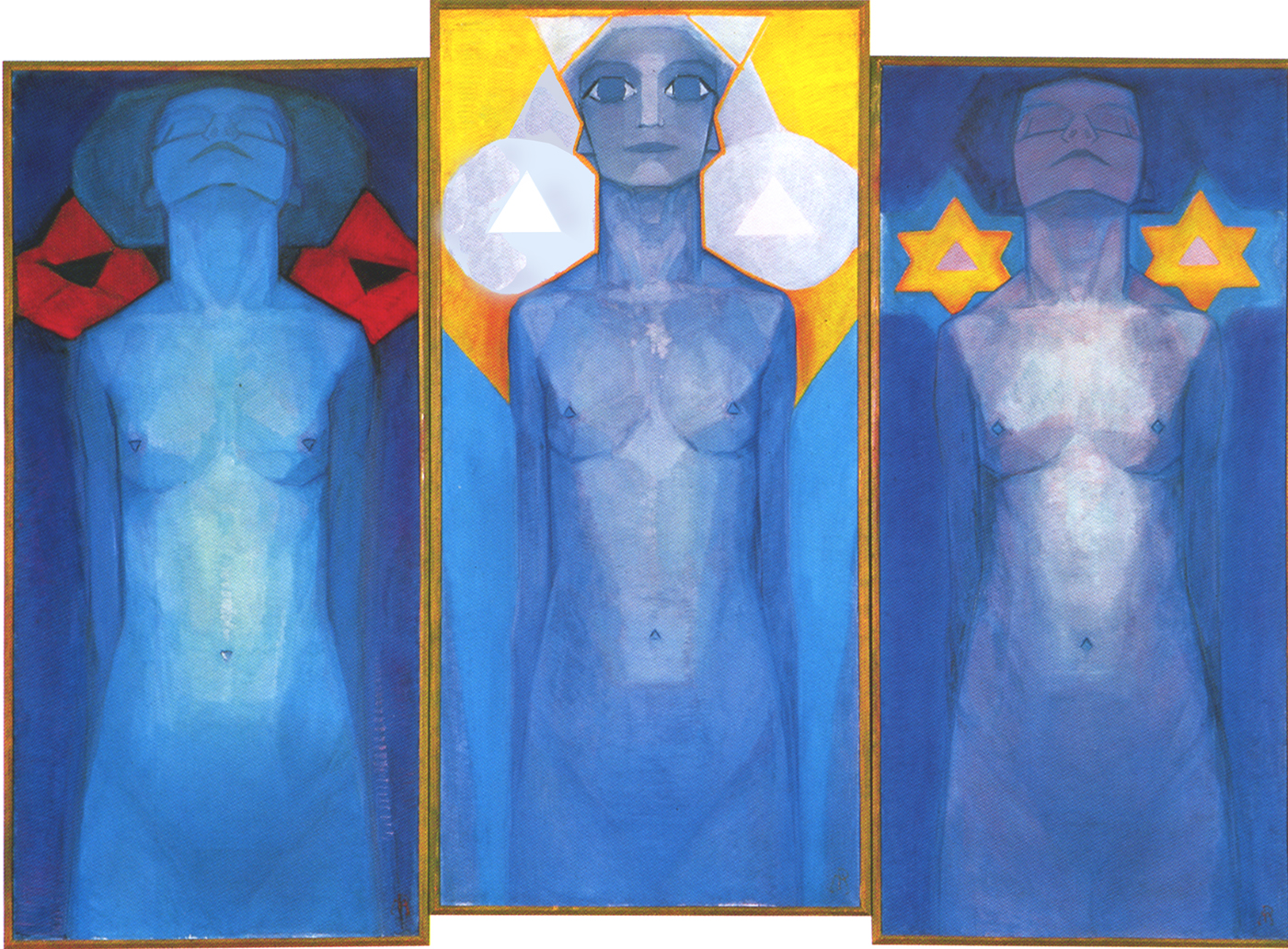
Central Panel cm. 87,5 x 183, Side Panels cm. 85 x 178
A spiritual evolution
The work consists of three rectangular panels of vertical proportions juxtaposed to form a triptych. The central panel is slightly raised with respect to those on either side, which has been interpreted as a sign of its greater importance.
The painting represents three fundamental stages in the spiritual evolution of a human being. The figure seems to be a woman but is in actual fact devoid of any female characteristics and should more probably be seen as a symbol of the human being, i.e. both male and female.
As noted above, the subject of a female figure with two flowers had already figured in previous works such as Passion Flower for example. In this case, the flowers become geometric shapes that I shall, however, continue to call flowers.
Art critics have said
The critics have interpreted the painting as follows. The work should be read starting with the panel on the left and continuing with the one on the right before finishing off with the one in the middle.
The panel on the left represents the human condition in the stage of life that is still lived unconsciously, following the emotional urges of the moment rather than any clear inner vision. The face is in fact shown in a state of slumber. The red color of the two flowers evokes the sphere of the passions. The black triangles seen in the center of the two red flowers are pointing downward to indicate the earth. The panel on the right represents the awakening of the spirit.
The two flowers are lightened with yellow and the black triangles become white and point upward. Finally, the figure with open eyes in the central panel represents the attainment of fully conscious life. Reading from left to right and then returning to the center, we thus see the evolution of a human being a from a condition in which life is lived “blindly”, so to speak, to a condition of full self-awareness.
I believe that while this interpretation is essentially correct, it does not wholly correspond to what is seen in the painting.
My interpretation
While I agree that we should start from the panel on the left and interpret it as stated above, I see the second stage of the process, i.e. the phase of awakening, as represented by the central panel rather than the one on the right, which would instead represent the conclusion of the process of evolution.

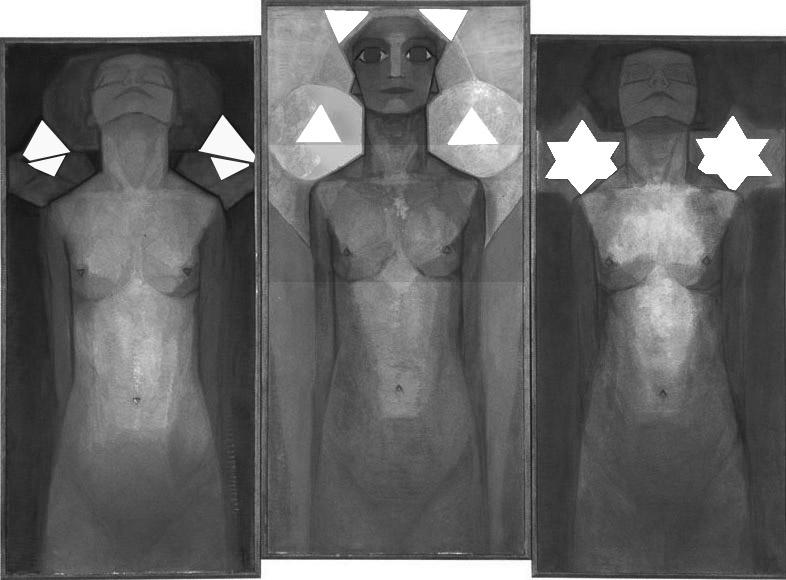
If we observe the two stylized flowers on either side of the face in all three panels, we note that in the first panel they are red and irregular in shape with an upward-pointing apex in contrast to the clearly visible downward-pointing black triangle in the middle. In the central panel the two red flowers become white halos of a circular shape with two juxtaposed white triangles above them.
These two triangles can be seen as originating from those in the previous panel, where the black triangle (pointing downward) predominates with respect to the red field that evokes an embryonic triangle pointing upwards. Although it is pointing upward, the latter remains imprisoned by the red. In the second panel the two triangles emerge from the “flower” and assume the same color, thus acquiring the same value in the eyes of the figure. A triangle pointing down alludes to matter while a triangle pointing up indicates spirit.
There is an equivalence of matter and spirit, body and mind in the moment of enlightenment.

In the third panel, finally, the two triangles become yellow and interpenetrate to form a six-pointed star, thus indicating a synthesis and unity between upper and lower, the earth and the heavens, matter and spirit.
The progressive interpenetration of the triangles shows that the central panel is not the last stage but rather phase of transition in a process moving from a condition of duality (the first panel) toward the synthesis and unity of opposites (the third panel).
A small white triangle pointing upward can be seen inside the six-pointed star, just as two faint white triangles can be seen pointing upward in the round halos of the central panel. This is probably meant to express a predominance of the spiritual with respect to the natural, which is considered necessary for human life.
Mind and body
During the phase of enlightenment (the central panel), the yellow space around the head seems to converge toward the stomach of the figure as though to establish communication between the spiritual vision and the more humoral and visceral part. This panel represents attainment of the unity of mind and body.
The duality of spirit and matter is faintly perceived in the first panel, where the sharply defined black triangle points downward and an embryonic red triangle points upward somewhat less forcefully. It then appears with greater clarity and luminosity with the two white triangles openly juxtaposed in the second panel. In the third panel it is finally resolved in a unitary synthesis (the yellow stars).
That the third panel expresses a synthesis of the first two can also be deduced from other details:
The two nipples and the navel are represented by triangular shapes that point downward in the first panel and upward in the second before combining in the third to form a faint rhombus, i.e. a geometric shape made up of two triangles (one pointing upward and the other downward) joined together.

While the eyes are again closed in the right-hand panel, the face is not tilted backward as strongly as in the first. The expression of the face in the left-hand panel shows a lack of consciousness, whereas the face on the right seems to suggest a secret awareness acquired in the moment of enlightenment and then internalized. The fact that this is a process of internalization is also indicated by the yellow field in the central panel and its concentration in the two stars of the third panel, which make the awareness achieved visible.
Outer and inner worlds
The color of the body also changes. The blue in the left panel is warmer than in the central panel and even more so with respect to the one on the right, where the blue appears the coldest of all.
While this is certainly related to the need to balance the red with a warmer shade of blue, I believe that it also stems from a desire to express a gradual movement of inner space toward the outside (the yellow and the cerulean blue of the central panel are in fact external space with respect to the figure) and, conversely, from the outside toward the inside with the yellow of the central panel concentrating in the two stars of the right panel, which, as noted above, represent inner life.
There is an externalization of interiority from the left to the center (with the warmer blue moving from the body of the figure to the outside) and then an internalization of exteriority from the center to the right (with the outer yellow concentrated in two stars symbolizing interiority).
Piet Mondrian’s vision
Externalization of the inner and internalization of the outer: this is essentially the process that every human being carries out during life.
Externalizing the inner means taking cognizance of oneself and becoming aware of one’s unconscious or real nature. Internalizing the outer means learning from one’s experience of the world. I am therefore inclined to read the process of evolution as the representation of the transition from a condition devoid of consciousness (left panel) to awareness (central panel), a mental vision (the eyes wide open) that is then introjected and assimilated in the right panel, where the vision thought becomes a vision felt, a vision of the spirit that sees everything with no more need to look.
No one lives in a permanent state of enlightenment. This cannot be so even for the most inspired mystics. There is the moment of clear vision and then abandonment to what has been understood, abandonment to a faith that no longer needs to see in order to believe.
The world within
I suppose that the purpose of the raised position of the central panel is to indicate a moment of particular spiritual intensity that Mondrian – but not only Mondrian – identifies with the vertical. The vertical thrust contrasts with the horizontal sequence of the three panels and therefore reinforces the reading from left to right. The act of raising does not serve the central panel so much as the one on the right, where the figure is concentrated within itself. By opposing the horizontal sequence, the vertical thrust strengthens its last stage, namely the moment of concentration within oneself.
This interpretation of Evolution will find further confirmation with our examination of Broadway Boogie Woogie.
Visit next page: Mondrian’s Cubism
back to overview
Copyright 1989 – 2025 Michael (Michele) Sciam All Rights Reserved More
